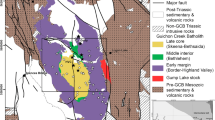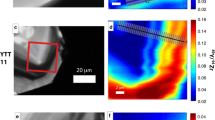Abstract
Zircon is a key mineral in geochemical and geochronological studies in a range of geological settings as it is mechanically and chemically robust. However, distortion of its crystal lattice can facilitate enhanced diffusion of key elements such as U and Pb. Electron backscatter diffraction (EBSD) analysis of ninety-nine zircons from the Lewisian Gneiss Complex (LGC) of northwest Scotland has revealed five zircons with lattice distortion. The distortion can take the form of gradual bending of the lattice or division of the crystal into subgrains. Zircon lattices are distorted because of either post-crystallisation plastic distortion or growth defects. Three of the five distorted zircons, along with many of the undistorted zircons in the population, were analysed by ion microprobe to measure U and Pb isotopes, Ti and REEs. Comparison of Th/U ratio, 207Pb/206Pb age, REE profile and Ti concentration between zircons with and without lattice distortion suggests that the distortion is variably affecting the concentration of these trace elements and isotopes within single crystals, within samples and between localities. REE patterns vary heterogeneously, sometimes relatively depleted in heavy REEs or lacking a Eu anomaly. Ti-in-zircon thermometry records temperatures that were either low (~700 °C) or high (>900 °C) relative to undistorted zircons. One distorted zircon records apparent 207Pb/206Pb isotopic ages (−3.0 to +0.3 % discordance) in the range of ~2,420–2,450 Ma but this does not correlate with any previously dated tectonothermal event in the LGC. Two other distorted zircons give discordant ages of 2,331 ± 22 and 2,266 ± 40 Ma, defining a discordia lower intercept within error of a late amphibolite-facies tectonothermal event. This illustrates that Pb may be mobilised in distorted zircons at lower metamorphic grade than in undistorted zircons. These differences in trace element abundances and isotope systematics in distorted zircons relative to undistorted zircons are generally interpreted to have been facilitated by subgrain walls. Trace elements and isotopes would have moved from undistorted lattice into these subgrain walls as their chemical potential is modified due to the presence of the dislocations which make up the subgrain wall. Subgrain walls provided pathways for chemical exchange between crystal and surroundings. Only five per cent of zircons in this population have lattice distortion suggesting it will not have a major impact on zircon geochronology studies, particularly as three of the five distorted zircons are from strongly deformed rocks not normally sampled in such studies. However, this does suggest there may be a case for EBSD analysis of zircons prior to geochemical analysis when zircons from highly deformed rocks are to be investigated.









Similar content being viewed by others
References
Ando J et al (2001) Striped iron zoning of olivine induced by dislocation creep in deformed peridotites. Nature 414(6866):893–895
Bestmann M, Prior DJ, Grasemann B (2006) Characterisation of deformation and flow mechanics around porphyroclasts in a calcite marble ultramylonite by means of EBSD analysis. Tectonophysics 413(3–4):185–200
Boyle AP, Prior DJ, Banham MH, Timms NE (1998) Plastic deformation of metamorphic pyrite: new evidence from electron-backscatter diffraction and forescatter orientation-contrast imaging. Miner Deposita 34(1):71–81
Cherniak DJ, Watson EB (2003) Diffusion in zircon. In Hanchar JM, Hoskin PWO (eds) Zircon. Reviews in Mineralogy and Geochemistry. Mineralogical Society of America and the Geochemical Society
Cherniak DJ, Hanchar JM, Watson EB (1997) Rare-earth diffusion in zircon. Chem Geol 134(4):289–301
Corfu F, Heaman LM, Rogers G (1994) Polymetamorphic evolution of the Lewisian Complex, NW Scotland, as recorded by U-Pb isotopic compositions of zircon, titanite and rutile. Contrib Miner Petrol 117(3):215–228
Corfu F, Hanchar JM, Hoskin PWO, Kinny PD (2003) Atlas of zircon textures. In: Hanchar JM, Hoskin PWO (eds) Zircon. Reviews in Mineralogy and Geochemistry. Mineralogical Society of America and the Geochemical Society
Cottrell AH, Bilby BA (1949) Dislocation theory of yielding and strain ageing of iron. Proc Phys Soc London, Sect A 62(1):49–62
Drury MR (2005) Dynamic recrystallization and strain softening of olivine aggregates in the laboratory and the lithosphere. Geological Society, London, Special Publications 243(1):143–158
Evans CR (1965) Geochronology of the Lewisian basement near Lochinver, Sutherland. Nature 204:638–641
Ferry JM, Watson EB (2007) New thermodynamic models and revised calibrations for the Ti-in-zircon and Zr-in-rutile thermometers. Contrib Miner Petrol 154(4):429–437
Finch RJ, Hanchar J (2003) Structure and chemistry of zircon and zircon-group minerals. In Hanchar J, Hoskin PWO (eds) Zircon. Reviews in Mineralogy and Geochemistry. Mineralogical Society of America and the Geochemical Society
Friend CRL, Kinny PD (1995) New evidence for protolith ages of Lewisian granulites, northwest Scotland. Geology 23(11):1027–1030
Gleason GC, Tullis J, Heidelbach F (1993) The role of dynamic recrystallization in the development of lattice preferred orientations in experimentally deformed quartz aggregates. J Struct Geol 15(9–10):1145–1168
Harrison TM, Schmitt AK (2007) High sensitivity mapping of Ti distributions in Hadean zircons. Earth Planet Sci Lett 261(1–2):9–19
Hart EW (1957) On the role of dislocations in bulk diffusion. Acta Metall 5(10):597
Heaman LM, Tarney J (1989) U-Pb baddeleyite ages for the Scourie dyke swarm, Scotland—evidence for 2 distinct intrusion events. Nature 340(6236):705–708
Heilbronner R, Tullis J (2006) Evolution of c axis pole figures and grain size during dynamic recrystallization: results from experimentally sheared quartzite. J Geophys Res 111(B10):B10202
Hinton RW (1999) NIST SRM 610, 611 and SRM 612, 613 multi-element glasses: constraints from element abundance ratios measured by microprobe techniques. Geostandards Newsletter-The Journal of Geostandards and Geoanalysis 23(2):197–207
Hiraga T, Anderson IM, Kohlstedt DL (2003) Chemistry of grain boundaries in mantle rocks. Am Mineral 88(7):1015–1019
Kelly NM, Harley SL (2005a) An integrated microtextural and chemical approach to zircon geochronology: refining the Archaean history of the Napier Complex, east Antarctica. Contrib Miner Petrol 149(1):57–84
Kelly NM, Harley SL (2005b) Timing of zircon growth during highgrade metamorphism: constraints from garnet-zircon REE. Geochim Cosmochim Acta 69(10):A22
Kelly NM, Hinton RW, Harley SL, Appleby SK (2008) New SIMS U-Pb zircon ages from the Langavat Belt, South Harris, NW Scotland: implications for the Lewisian terrane model. Journal of the Geological Society 165:967–981
Kinny PD, Friend CRL (1997) U-Pb isotopic evidence for the accretion of different crustal blocks to form the Lewisian Complex of northwest Scotland. Contrib Miner Petrol 129:326–340
Kinny PD, Friend CRL, Love GJ (2005) Proposal for a terrane-based nomenclature for the Lewisian Gneiss Complex of NW Scotland. Journal of the Geological Society 162:175–186
Larche FC, Cahn JW (1985) The interactions of composition and stress in crystalline solids. Acta Metall 33(3):331–357
Lister GS, Dornsiepen UF (1982) Fabric transitions in the Saxony granulite terrain. J Struct Geol 4(1):81–92
Ludwig KR (2003) User’s manual for Isoplot 3.00: a geochronological toolkit for Excel. Special Publications, 4. Berkeley Geochronological Center
Maas R, Kinny PD, Williams IS, Froude DO, Compston W (1992) The Earths oldest known crust—a geochronological and geochemical study of 3900-4200 Ma old detrital zircons from Mt Narryer and Jack Hills, Western-Australia. Geochim Cosmochim Acta 56(3):1281–1300
Mariani E, Mecklenburgh J, Wheeler J, Prior DJ, Heidelbach F (2009) Microstructure evolution and recrystallization during creep of MgO single crystals. Acta Mater 57(6):1886–1898
McDonough WF, Sun SS (1995) The composition of the Earth. Chem Geol 120(3–4):223–253
Pal DC, Chaudhuri T, McFarlane C, Mukherjee A, Sarangi AK (2011) Mineral Chemistry and in situ dating of allanite, and Geochemistry of its host rocks in the Bagjata Uranium Mine, Singhbhum Shear Zone, India-implications for the chemical evolution of REE mineralization and mobilization. Econ Geol 106(7):1155–1171
Park RG (1970) Observations on Lewisian chronology. Scott J Geol 6(4):379–399
Peach BN, Horne J, Gunn W, Clough CT, Hinxman LW (1907) The geological structure of the northwest highlands of Scotland. Memoirs of the geological survey. H.M.S.O., London
Penn RL, Banfield JF (1998) Imperfect oriented attachment: dislocation generation in defect-free nanocrystals. Science 281(5379):969–971
Piazolo S, Austrheim H, Whitehouse M (2012) Brittle-ductile microfabrics in naturally deformed zircon: deformation mechanisms and consequences for U-Pb dating. Am Mineral 97(10):1544–1563
Pinilla C, Davis SA, Scott TB, Allan NL, Blundy JD (2012) Interfacial storage of noble gases and other trace elements in magmatic systems. Earth Planet Sci Lett 319:287–294
Prior DJ et al (1999) The application of electron backscatter diffraction and orientation contrast imaging in the SEM to textural problems in rocks. Am Mineral 84(11–12):1741–1759
Prior DJ, Mariani E, Wheeler J (2009) EBSD in the Earth Sciences: applications, common practice and challenges. In: Schwartz AJ, Kumar M, Adams BL, Field DP (eds) Electron backscatter diffraction in materials science. Springer, Berlin
Reddy SM et al (2006) Crystal-plastic deformation of zircon: a defect in the assumption of chemical robustness. Geology 34(4):257–260
Slama J et al (2008) Plesovice zircon—a new natural reference material for U-Pb and Hf isotopic microanalysis. Chem Geol 249(1–2):1–35
Stipp M, Tullis J (2003) The recrystallized grain size piezometer for quartz. Geophys Res Lett 30:2088–2093
Sutton J, Watson J (1951) The pre-Torridonian metamorphic history of the Loch Torridon and Scourie areas in the North-West Highlands, and its bearing on the chronological classification of the Lewisian. Quarterly Journal of the Geological Society 106:241–296
Takeuchi S, Argon AS (1979) Glide and climb resistance to the motion of an edge dislocation due to dragging a Cottrell atmosphere. Philosophical Magazine a-Physics of Condensed Matter Structure Defects and Mechanical Properties 40(1):65–75
Tarney J, Weaver BL (1987) Geochemistry of the Scourian complex: petrogenesis and tectonic models. In: Park RG, Tarney J (eds) Evolution of the Lewisian and comparable precambrian high-grade terrains. Blackwell, Oxford
Timms NE, Kinny PD, Reddy SM (2006a) Deformation-related modification of U and Th in zircon. Geochim Cosmochim Acta 70(18):A651
Timms NE, Kinny PD, Reddy SM (2006b) Enhanced diffusion of Uranium and Thorium linked to crystal plasticity in zircon. Geochem Trans 7:1–16
Timms NE et al (2011) Relationship among titanium, rare earth elements, U-Pb ages and deformation microstructures in zircon: implications for Ti-in-zircon thermometry. Chem Geol 280(1–2):33–46
Watson EB, Wark DA, Thomas JB (2006) Crystallization thermometers for zircon and rutile. Contrib Miner Petrol 151(4):413–433
Wheeler J et al (2009) The weighted Burgers vector: a new quantity for constraining dislocation densities and types using electron backscatter diffraction on 2D sections through crystalline materials. J Microsc 233(3):482–494
Wiedenbeck M et al (1995) Three natural zircon standards for U-Th-Pb, Lu-Hf, trace element and REE analyses. Geostandards Newsletter 19(1):1–23
Wilde J, Cerezo A, Smith GDW (2000) Three-dimensional atomic-scale mapping of a Cottrell atmosphere around a dislocation in iron. Scripta Mater 43(1):39–48
Zhao JZ, De AK, De Cooman BC (2001) Formation of the Cottrell atmosphere during strain aging of bake-hardenable steels. Metallurgical and Materials Transactions a-Physical Metallurgy and Materials Science 32(2):417–423
Acknowledgments
This work was carried out under UK Natural Environment Research Council DTG NE/G523855/1 and British Geological Survey CASE Studentship 2K08E010 to JMM. Carmel Pinnington and Eddie Dempsey are thanked for assistance with SEM analysis. Ion microprobe analysis at the Edinburgh Ion Microprobe Facility was carried out with funding from NERC grant IMF384/1109; Richard Hinton, Cees-Jan De Hoog and John Craven are thanked for ion microprobe support and Mike Hall for assistance with sample preparation. Detailed reviews by Martin Whitehouse and an anonymous reviewer, plus discussions with Alan Boyle, Craig Storey and Nick Roberts, considerably improved this manuscript. KMG publishes with the permission of the Executive Director of the Geological Survey.
Author information
Authors and Affiliations
Corresponding author
Additional information
Communicated by J. Blundy.
Rights and permissions
About this article
Cite this article
MacDonald, J.M., Wheeler, J., Harley, S.L. et al. Lattice distortion in a zircon population and its effects on trace element mobility and U–Th–Pb isotope systematics: examples from the Lewisian Gneiss Complex, northwest Scotland. Contrib Mineral Petrol 166, 21–41 (2013). https://doi.org/10.1007/s00410-013-0863-8
Received:
Accepted:
Published:
Issue Date:
DOI: https://doi.org/10.1007/s00410-013-0863-8




